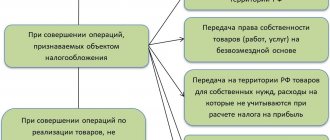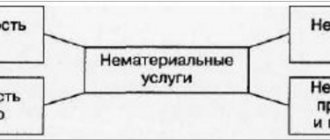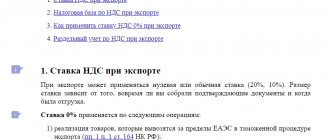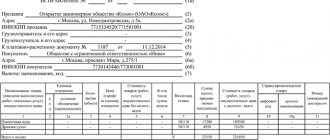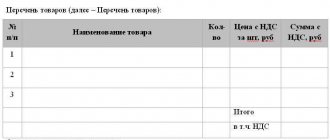Home / Uncategorized / In how many copies is an invoice issued?
In this case, taxpayers who have received an exemption from fulfilling their duties as a taxpayer issue invoices without allocating the corresponding tax amounts. In this case, the invoice is inscribed or stamped “Without tax (VAT)” (Clause 5 of Article 168 of the Tax Code of the Russian Federation). Invoices are not drawn up: - for transactions involving the sale of securities (except for brokerage and intermediary services) (clause 4 of Article 169 of the Tax Code of the Russian Federation); - banks, insurance organizations and non-state pension funds for transactions not subject to VAT in accordance with Art. 149 of the Tax Code of the Russian Federation (clause 4 of Article 169 of the Tax Code of the Russian Federation); -for goods (works, services) sold by entities that are not VAT payers. Thus, invoices are not prepared by: small enterprises using a simplified system of taxation, accounting and reporting; enterprises transferred to pay a single tax on imputed income; - when selling goods for cash by retail trade and public catering organizations and other organizations that perform work and provide paid services directly to the population for cash using a cash register, subject to the issuance of a cash receipt to the buyer (clause 7 of Article 168 of the Tax Code of the Russian Federation); - when selling goods (work, services) directly to the population in cash without using cash registers in cases provided for by the legislation of the Russian Federation (clause 7 of article 168 of the Tax Code of the Russian Federation). In these cases, instead of invoices, valid strict reporting forms or valid primary accounting documents are used (when making settlements with the public through branches of credit institutions, post offices, etc.), which are registered in the sales book.
Accounting and legal services
Analytical accounting for account 62 in Stimul-2 LLC is maintained for each invoice presented by the buyer or customer, and for settlements in the order of scheduled payments - for each buyer or customer. The construction of analytical accounting provides data on debt secured by: bills of exchange for which the receipt of funds has not arrived; bills discounted (discounted) in banks; bills for which funds were not received on time.
Please note => Receipt form for payment of state duty for opening an individual entrepreneur 2020
Invoice how many copies
- in line 1
- the serial number and date of issue of the invoice. When drawing up an invoice by the principal (principal) to the commission agent (agent) selling goods (work, services), property rights on his own behalf, as well as when drawing up in this case an invoice by the commission agent (agent) to the buyer in this line of such invoices a single date is indicated - the date the invoice is issued by the commission agent (agent) to the buyer; - in line 2
- the full and abbreviated name of the seller in accordance with the constituent documents; - in line 2a
- the location of the seller in accordance with the constituent documents; - in line 2b
- identification number and reason code for registering the taxpayer-seller; - in line 3
- the full or abbreviated name of the shipper in accordance with the constituent documents. If the seller and the shipper are the same person, then “he” is written in this line. Otherwise, the postal address of the shipper is indicated. When drawing up an invoice for work performed (services provided), property rights are marked with dashes in this line; - in line 4
- the full or abbreviated name of the consignee in accordance with the constituent documents and his postal address; - in line 5
- details (number and date of preparation) of the payment document or cash receipt (when making payments using payment documents or cash receipts, to which an invoice is attached).
When drawing up an invoice upon receipt of the payment amount, partial payment for upcoming deliveries of goods (performance of work, provision of services), transfer of property rights using a non-cash
form of payment, dashes are placed in this line. When drawing up an invoice by the tax agent specified in paragraph 4 of Article 174 of the Tax Code of the Russian Federation, this line indicates the number and date of the payment and settlement document indicating the transfer of the tax amount to the budget.; - in line 6
- the full or abbreviated name of the buyer in accordance with the constituent documents; - in line 6a
- the location of the buyer in accordance with the constituent documents; - in line 6b
- identification number and code of the reason for delivery to the taxpayer-buyer's account.
Please note => Audit of claims work on loans
Sales of finished products produced during the month of production
Regulatory regulation
Sales are recognized as the transfer of ownership of goods on a reimbursable basis (Article 39 of the Tax Code of the Russian Federation). Finished products are part of the organization’s inventories, which are the end result of the production cycle and have quality characteristics that comply with the terms of the contract (clause 199 of the Methodological Guidelines for the Accounting of Inventory Production, approved by Order of the Ministry of Finance of the Russian Federation dated December 28, 2001 N 119n). Sales of finished products are reflected in the same way as sales of goods.
Organizations engaged in production activities, for the purpose of calculating income tax, take into account income and expenses associated with the production and sale of finished products.
Income:
- In the accounting system, revenue from the sale of finished products is classified as income from ordinary activities (clause 5 of PBU 9/99) and is recognized at the moment of transfer of ownership of the product (clause 12 of PBU 9/99).
- In NU, income is revenue from sales excluding VAT (Clause 1, Article 248 of the Tax Code of the Russian Federation, Article 249 of the Tax Code of the Russian Federation). The date of receipt of income using the accrual method is the date of sale of products (Article 271 of the Tax Code of the Russian Federation).
Expenses:
- In accounting, this is the actual cost of finished products (clause 5, clause 9 of PBU 10/99). The method for assessing finished products in the warehouse (clauses 203, 204 of the Methodological Guidelines for the Accounting of Inventory Plants, approved by Order of the Ministry of Finance of the Russian Federation dated December 28, 2001 N 119n) is established in the accounting policy.
- In NU, expenses that reduce sales revenue include the amounts of expenses associated with the production and sale of products (Article 318 of the Tax Code of the Russian Federation): direct and indirect. Direct costs included in the cost of finished products are written off as they are sold.
Accounting in 1C
Sales of finished products are documented in the document Sales (act, invoice) transaction type Goods (invoice) in the section Sales – Sales – Sales (acts, invoices).
The header of the document states:
- Agreement - a document according to which settlements are made with the buyer, Type of agreement - With the buyer .
In our example, calculations are carried out in rubles, which is noted in 1C in the PDF delivery agreement. Therefore, in the Sales document (act, invoice) the following sub-accounts are automatically established for settlements with the buyer:
- Settlement account - 62.01 “Settlements with buyers and customers.”
- Advances account - 62.02 “Calculations for advances received.”
If necessary, accounts for settlements with the buyer can be corrected in the document manually or configured for the automatic insertion of other accounts for settlements with the counterparty.
The tabular part indicates the products sold from the Nomenclature directory.
- Accounts are filled in the document automatically, depending on the settings in the Item Accounts .
For the item type Products PDF, the default Accounting Account “Finished Products”, but it can be changed manually in the document.
Find out more about setting up item accounting accounts
- Income account - 90.01.1 “Revenue from activities with the main tax system.”
- Expense account - 90.02.1 “Cost of sales for activities with the main tax system.”
- VAT account - 90.03 “Value added tax”.
- Nomenclature groups - a nomenclature group related to the sale of products produced in-house, selected from the Nomenclature Groups directory. The item group is automatically filled in . PDF
The nomenclature group related to the sale of products of own production must be indicated in the Nomenclature groups for the sale of products and services PDF in the Main section - Settings - Taxes and reports - Income Tax tab - link Nomenclature groups for the sale of products and services. The correct completion of the income tax return depends on this setting.
Read more Setting up accounting policies
Postings according to the document
If the sale of products is carried out in the month of its production, i.e. before the formation of the actual cost, then the amount for posting Dt 90.02.1 Kt will be equal to:
- The planned cost of finished products, if the planned cost of production is used when calculating output.
- Zero if the planned cost of production is not used when calculating output. PDF
The document generates transactions:
- Dt 90.02.1 Kt - write-off of the cost of finished products, without amount: production was carried out without using planned prices. PDF
- Dt 62.01 Kt 90.01.1 - revenue from the sale of finished products: in accounting accounting, including VAT;
- in NU excluding VAT;
If there is a balance of finished products in accounting at the beginning of the month, then in the Sales document (act, invoice) the cost of goods sold will be formed taking into account this balance and Inventory Valuation Method established in the Accounting Policy. But the final cost will be formed after completing the Month Closing procedure.
Documenting
The organization must approve the forms of primary documents, including the product sales document. The following basic forms are used in 1C:
- Consignment note in the form TORG-12. PDF
- Universal transfer document. PDF
Forms can be printed by clicking the Print button – Consignment note (TORG-12) and Print – Universal transfer document (UDD).
Income tax return
In the income tax return, the amount of proceeds from the sale of goods is reflected as income from sales:
Sheet 02 Appendix No. 1:
- page 010 “Proceeds from sales - total”, including: page 011 “... revenue from the sale of goods (works, services) of own production.” PDF
The invoice is signed
- A participant in a simple partnership agreement received an advance or shipped goods (work, services) under such an agreement
- Trustee - received an advance or shipped goods (work, services) under such an agreement
- Commission agent (agent acting on his own behalf) - received an advance or shipped goods (work, services) of the principal (principal) - VAT payer
- An intermediary involved in settlements has shipped goods (work, services) to a foreign person who is not registered for tax purposes in the Russian Federation, or received an advance payment for them
In how many copies is the invoice issued?
Nowadays, all organizations use accounting programs and any document can be printed repeatedly. In this regard, there is a question that I haven’t found an answer to specifically anywhere: How many invoices issued should be printed when generating them? - one or two? It is clear that one copy is given to the buyer for VAT reimbursement. In general, do we still need copies of issued invoices? Of course, someone will say that this is a personal matter for each accountant, that this is stated in the accounting policy. But if we take the legislative component of the formation of issued invoices, are second copies of this document needed in the accounting department of the selling organization? At the same time, it is written everywhere that the Seller is obliged to generate an invoice and register it in the Journal of issued invoices. AND SHOULD
Should the seller keep a second copy with the signatures of the issued invoice?
=== That is Is it necessary to keep an invoice issued by the selling organization in paper form or is it enough to just register it in a journal? === It would be nice to receive an answer with a link to some regulatory documents.
Thank you all for your participation. Please note => Housing services for public sector employees in St. Petersburg October 2020
Payment for goods in cash and non-cash
Let's consider two methods of payment for goods that are to be sold:
-cash payment (“cash”);
-cashless payment.
When paying in cash, paragraph 7 of Article 168 of the Tax Code of the Russian Federation provides for exemption from the obligation to issue an invoice for goods sold to an individual, provided that the buyer has been issued a cash receipt with an allocated amount of VAT and the seller has entered this transaction in the sales book (clause 1 “Rules for maintaining a sales book used in calculations of value added tax”, approved by Decree of the Government of the Russian Federation on December 26, 2011 No. 1137 (as amended on February 1, 2021)), i.e. thereby fulfilling the requirements of paragraph 3 of Art. 168 of the Tax Code of the Russian Federation on issuing invoices.
In the case of non-cash payment for goods sold at retail to an individual, the VAT payer is obliged to issue an invoice according to the general rule, with registration in the sales book, in accordance with the rules for maintaining the book specified above in the text.
In the explanatory letters of the tax legislation, the financial authorities noted that in the case of retail sales of goods to an individual, an invoice can be issued in a single copy, i.e. only for the seller for tax accounting purposes, since individuals are not VAT payers (clause 1, clause 3, article 169 of the Tax Code of the Russian Federation) and do not accept this tax for deduction.
It should be noted that in the sales book you can register an accounting statement, which contains the total amount of transactions performed for the sale of goods to individuals for a month or a quarter.
